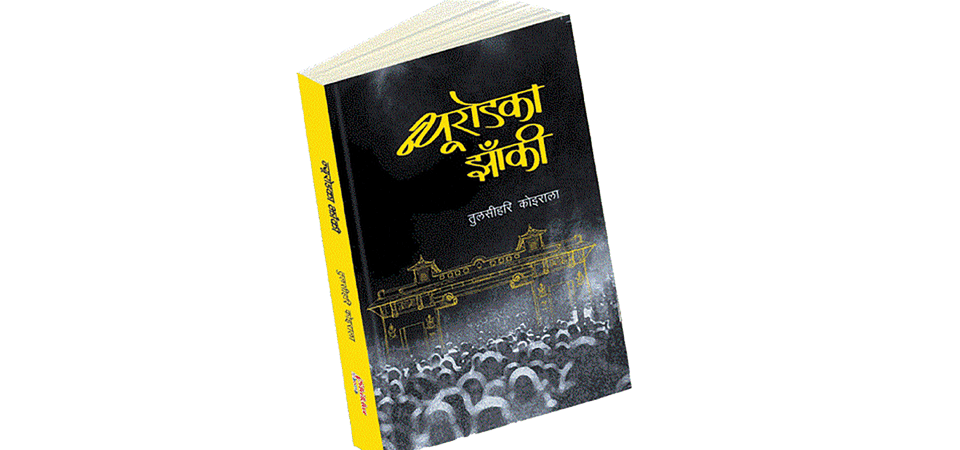Advocacy For The Neglected Class

Aashish Mishra
New Road is not just a street, it is a witness of Nepali history. Built after the 1934 earthquake, it saw the Rana regime at its peak slowly wither and ultimately fall in 1951. In the democracy years, it was the centre of political activity – be it speeches by leaders or protests by dissatisfied groups. The road also observed the three decades of repressive Panchayat rule and watched over the popular movement that toppled it in 1990. It saw the constitutional monarchy get thrown out in favour of federal secular republicanism.
And as New Road has been watching over the capital and the country, author Tulasi Hari Koirala has been watching over New Road for the past 23 years. The road seems to have known this and hence, showed him a lot of things that it seems to keep hidden from others. This special relationship between the road and the author is very well reflected in Koirala’s latest book “New Road Kaa Jhanki.”
Koirala is a long-time writer, having penned numerous poems, stories, essays and literature for children. He has half a dozen published works to his name. However, "New Road Kaa Jhanki" is his first anthology of stories and he could not have chosen a better theme to revolve around. The book is 185 pages long and has 19 stories, each more interesting than the last. The language is simple but powerful; the stories are short yet complete. Koirala, perhaps because of his background in journalism, can shape three-dimensional characters, convey their internal and external struggles and paint the world the book is set in in surprisingly few words. He explores all these issues of class, caste, gender, psychology, corruption, bureaucracy and sex without making the book dense. Throughout the 19 stories, he has also not lost sight of what the book is about – the Jhankis he saw at New Road. The book is well-structured, the narratives have a clear focus and the words do not burden the readers.
However, while being a journalist has certainly helped Koirala’s literary ventures, it has also held him back, as is visible in this book. The stories Koirala presents are too grounded and too real. There is no escapism here. The 19 stories are bleak, perhaps because the writer wanted to show the depressing reality of our society. But this robs the book of variety. You cannot have this many stories travelling in this many directions carry the same “realistic” tone without it feeling conscious and forced.
Also, in exploring gender and sexuality, the writer looks at women from a male perspective. This is a problem, not just in Nepali but in world literature. Male storytellers present their women characters as everything except human beings. They look at the contextuality, spirituality, ideology, physicality and romance of the women in their works while missing their basic humanity. The author ends up mansplaining what an ideal woman is. "New Road Kaa Jhanki" is certainly not egregious in this regard, at least not to this male reviewer. But the book, as a lens into the writer's world, has patriarchal tints in some places.
This takes nothing away from the biggest strength of this book though – "New Road Kaa Jhanki" can take the reader out of themselves. Oftentimes, we think we are the only victims on this Earth and that our problems are the only ones that matter. We are only engrossed in ourselves and our families and do not care enough to care that there is an entire world beyond our bloodline. This book changes that. By presenting the stories of the disadvantaged and marginalised strata of our society, Tulsi Hari Koirala forces the readers to stop thinking about themselves for a second and acknowledge the sufferings of others. "Yes, people are leading a better life than us but there are also people leading one much worse," the book says, "And if we cannot help them then let us at least empathise with them."
Koirala’s stories also force its readers to accept a heart-wrenching fact. The marginalised are marginalised because of our ignorance. It is not that we are not aware of their miseries, it is that we do not think to help. The destitute are not unseen or unheard, they are just neglected. The volume and the tales it contains is a condemnation of our apathy and self-centeredness.
All the 19 stories in the book are good but two “Chokyayiyeka Gaun” and “Pilo” stand out. The former depicts the struggles of the Dalit castes and excoriates our society’s hypocrisy. The so-called higher castes use religion and culture as a tool to oppress those labelled low caste and benefit off of their labour. Within the context of the draconian caste system, it also indicts the needless stigmatisation of the basic human desire of sex through Gharti and Damini’s relationship.
The latter is a story of corruption and how, sometimes, the innocent become accessories to misdeeds they want no part in.
This book is Koirala's advocacy for the neglected class. It invites the readers to question their behaviour and outlook on life.
Recent News

Do not make expressions casting dout on election: EC
14 Apr, 2022
CM Bhatta says may New Year 2079 BS inspire positive thinking
14 Apr, 2022
Three new cases, 44 recoveries in 24 hours
14 Apr, 2022
689 climbers of 84 teams so far acquire permits for climbing various peaks this spring season
14 Apr, 2022
How the rising cost of living crisis is impacting Nepal
14 Apr, 2022
US military confirms an interstellar meteor collided with Earth
14 Apr, 2022
Valneva Covid vaccine approved for use in UK
14 Apr, 2022
Chair Prachanda highlights need of unity among Maoist, Communist forces
14 Apr, 2022
Ranbir Kapoor and Alia Bhatt: Bollywood toasts star couple on wedding
14 Apr, 2022
President Bhandari confers decorations (Photo Feature)
14 Apr, 2022










